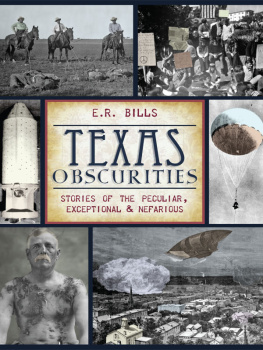Front cover art (titled Occidere) by Austin artist Paul Beck.
 | Copyright 2015
By E.R.Bills
Published By Eakin Press
An Imprint of Wild Horse Media Group
P.O. Box 331779
Fort Worth, Texas 76163
1-817-344-7039
www.EakinPress.com
ALL RIGHTS RESERVED
1 2 3 4 5 6 7 8 9
ISBN-10: 1-68179-018-1
ISBN-13: 978-1-68179-018-3 |
ALL RIGHTS RESERVED. No part of this book may be reproduced in any form without written permission from the publisher, except for brief passages included in a review appearing in a newspaper or magazine.
Table of Contents
- Preface
- Part II
- 2. 1861
- 3. 1863
- 4. 1867
- 5. 1876
- 6. 1890
- 7. 1891
- 8. 1892
- 9. 1895
- 10. 1901
- 11. 1902
- 12. 1905
- 13. 1908
- 14. 1909
- 15. 1910
- 16. 1912
- 17. 1915
- 18. 1916
- 19. 1919
- 20. 1920
- 21. 1921
- 22. 1922
- 23. 1924
- 24. 1930
- 25. 1933
- 26. Conclusion
- Endnotes
- Bibliography
- Index
- About the Author
Landmarks
- Table Of Contents
Preface
holocaust ( hl

kst ) n. [ME. < OFr. holocauste < LL. (Ec.) holocaustum, a whole burnt offering < Gr. holokauston (neut. of holokaustos), burnt whole < holos, whole + kaustos, burnt] 1. an offering the whole of which is burned; burnt offering 2. great or total destruction of life, esp. by fire the Holocaust [also h-] the systemic destruction of over six million European Jews by the Nazis before and during World War II.
T oday the contemporary connotation or common perception of the term holocaust relates to the extermination/genocide of Jews by the Nazis before and during World War II. The original denotation or actual meaning of the term holocaust, however, is burnt whole, a devastation of life by fire or a great or total destruction of life, especially by fire.
It can be argued that the Jews murdered by the Nazis were burnt whole, but they were not burned to death or deprived of life by fire; they were killed by gas or other means before they were burned. Whether or not their burnings comprised an offering is a matter of philosophical interpretation.
In 1893a half-century before holocaust came to signify the genocide perpetrated against the Jewsseveral holocausts occurred in the United States. A Chicago Holocaust resulted when twelve people accidentally burned to death in a building. A frightful holocaust occurred when seven men accidentally burned to death in a hotel in Beaver, Pennsylvania. A sickening holocaust took place when six people were accidentally burned alive at a lodging house in Burlington, Iowa. A fearful holocaust resulted when four people accidentally burned to death in a Cincinnati hotel. And a terrible holocaust occurred when a black man was tortured and burned at the stake in Paris, Texas.
In fact, the Paris Horror (as it was also called) would be referred to by Governor James Hogg, as the holocaust at Paris and it became a catalyst for a three-decade regimen of holocaust in Texas, intentionally perpetrated by whites against persons of color.
B urning a living, breathing human being at the stake is never simply a matter of murder or lynching. Its an act of terror, monstrosity and madness, and its political, societal and psychological repercussions are hardly quantifiable.
This book chronicles a period of holocaust and human cinder. If youre fragilewhite or blackthis is not a book for you.
E. R. Bills
I.
The Paris Horror
Masters of fiction have bent their energies to the utmost limits in efforts of word painting to show the extent to which cruelty of man may be carried, and still the horrors of mans inhumanity to man, as recorded in history, have not been reached by the most fertile imaginations. Accounts of Carthagenian cruelty, the horrors of the inquisitions of the Dark Ages, the fiendish torments inflicted upon prisoners by cruel savages, have curdled the blood of the reader for ages, but in no history, in no work of fiction, has such cruelty been reached as was witnessed at Paris, Texas, last week.
Dixon Evening Telegraph
February 4, 1893
T he population of Paris, Texas in the 1890s was close to 10,000. It was a big town, but not so big that folks in the know werent unaware of the troublesome sorts.
Henry Smith was an African American day-laborer in the community who liked to drink. When Smith was under the influence, he routinely had brushes with the law. Henry Vance was a white policeman who apparently had a penchant for beating suspects while they were in his custody.
Sometime around mid to late 1892 or early 1893, Smiths vice and Vances penchant planted the seeds for a gruesome murder and a hellish lynching. Vance viciously beat or bullied Smith and Smith apparently devised a plan for vengeance. On the afternoon of Wednesday, January 24, 1893, Smith reportedly grabbed Vances three-and-a-half-year-old daughter, Myrtle, and took her to the out-skirts of town. Young Myrtle put up little resistance and Smith, initially at least, may not have had a clear notion as to what he would do with her.
Several witnesses, including Paris mayor Alexander Cate, claimed they saw Smith carrying Myrtle through town and thought little or nothing of it. African Americans in the South were still regularly employed as house servants, and the sight of a black man transporting Myrtle hardly registered except to one other little girl. As Smith allegedly passed by with Myrtle in his arms, the girl saw them and ran to her father, insisting he make Smith put Myrtle down. But the unidentified girls father assumed Smith was collecting her for her folks.
As the cool January afternoon gave way to chilly evening, Myrtle didnt return home. By nightfall, the child was missed and the Vance family inquired after her, performing a cursory search. According to reports, Henry Vance was not overly troubled about Myrtles whereabouts until he learned of Smiths possible involvement. And even then Vances behavior was oddly subdued, as if he assumed Myrtles disappearance was something of a prank rather than a matter of life or death.
Whatever the case, when the direction Smith reportedly carried Myrtle out of town was made known, Vance and a small search party examined the route and found nothing. Thenperhaps also curiouslythe search was retired for the evening.
When Myrtle didnt return the following morning, a broader, organized investigation was conducted. Posses went out in every direction and one party went by Smiths estranged wife Sues residence and spoke with her. Sue told investigators that Henry had spent the night out, returning home around daylight. She also said that when he came in he ordered her to fix him something to eat.












 kst ) n. [ME. < OFr. holocauste < LL. (Ec.) holocaustum, a whole burnt offering < Gr. holokauston (neut. of holokaustos), burnt whole < holos, whole + kaustos, burnt] 1. an offering the whole of which is burned; burnt offering 2. great or total destruction of life, esp. by fire the Holocaust [also h-] the systemic destruction of over six million European Jews by the Nazis before and during World War II.
kst ) n. [ME. < OFr. holocauste < LL. (Ec.) holocaustum, a whole burnt offering < Gr. holokauston (neut. of holokaustos), burnt whole < holos, whole + kaustos, burnt] 1. an offering the whole of which is burned; burnt offering 2. great or total destruction of life, esp. by fire the Holocaust [also h-] the systemic destruction of over six million European Jews by the Nazis before and during World War II.